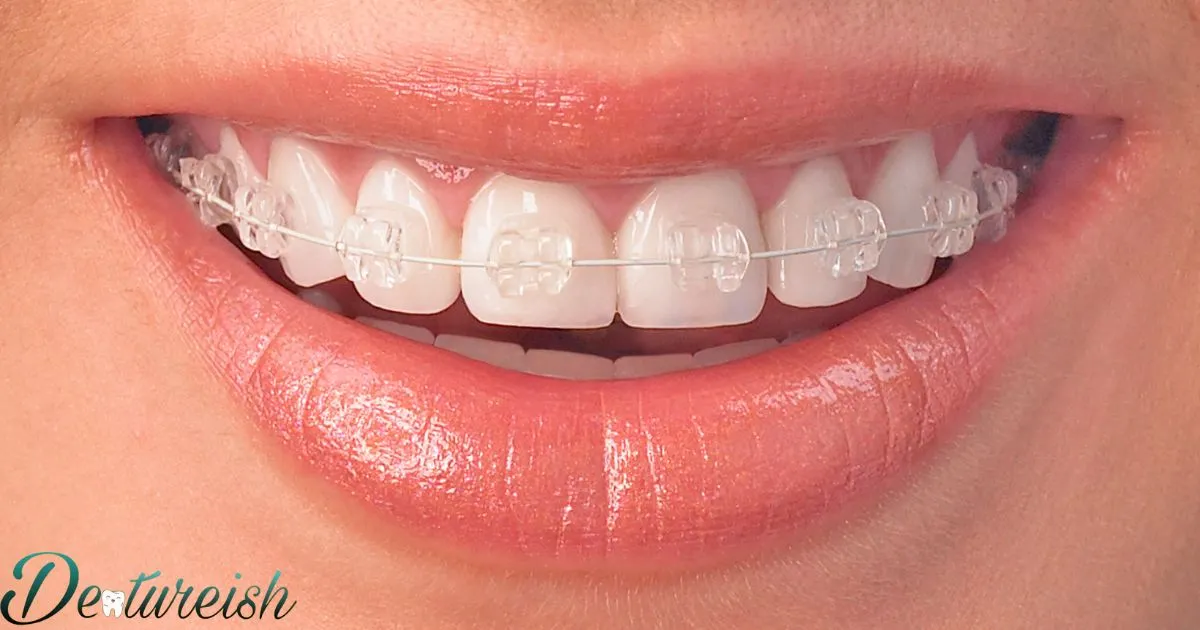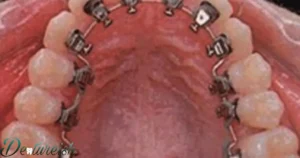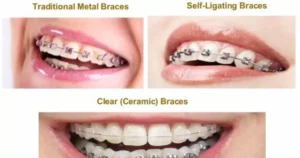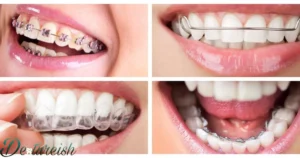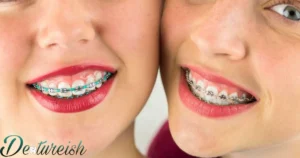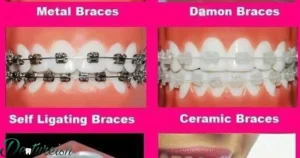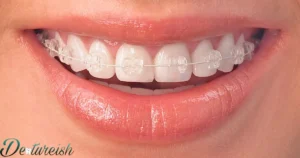Metal braces are devices used in orthodontics to align teeth and help position them properly. They are usually made of metal alloy materials and fitted to teeth.
Standard Metal Braces Or Equivalent Only? This common dental quote makes patients question what equivalent options might be. Are there newer invisible choices, or only traditional wired appliances?
Standard metal braces have been used successfully for decades to subtly shift teeth into their ideal positions. Sometimes clear aligners or lingual options are deemed “equivalent” alternatives by an orthodontist.
What Are Standard Metal Braces And How Do They Work?
Standard metal braces are the most common type of orthodontic treatment. They are made of stainless steel wires and brackets. The brackets are bonded to the front of the teeth using a type of dental glue. Tiny elastic bands or wires connect the brackets and put gentle pressure on the teeth. This pressure slowly moves the teeth into the right position over time.
The brackets are usually bonded to the front, visible surfaces of the teeth. Different colored rubber bands or wires link the brackets together. As the patient bites down or moves their mouth, the connections between the brackets exert pressure. This pressure is what nudges the teeth into a straighter, healthier alignment.
The Components Of Standard Metal Braces
Standard metal braces have several key components. Stainless steel brackets are bonded to the front of each tooth. An archwire slides into a tiny slot in each bracket and connects all of the brackets together. Ligatures like elastic rings or tightening screws hold the archwire firmly in place.
At the core of standard braces is the archwire. It runs through a slot in each bracket and applies correcting pressure on the teeth as it seeks to take on the perfect arch shape. The orthodontist chooses archwires made of various metals that provide different levels of stiffness or flexibility. Over time, they switch to progressively stronger wires that are better able to hold reshaped teeth in place.
Braces Apply Gentle Pressure To Move Teeth
5 easy tips for applying gentle pressure to move teeth when wearing braces
- Chew gum – Chewing gum applies even pressure all over the teeth and can help speed up the movement process. Choose sugar-free gum to avoid cavities.
- Use chewlery – Chewlery are chewable necklaces or chewable toys that can be placed on top or between teeth and gently chewed to apply pressure.
- Gently bite down – Try lightly clenching or biting down after meals. This helps apply slight force to teeth that need to shift. Be very gentle.
- Massage wire – Ask your orthodontist, but you may gently massage the wire with your fingertip to apply slight pressure in the direction teeth need to move.
- See your orthodontist regularly – Weekly or monthly checkups allow your orthodontist to tighten or adjust braces as needed to guide teeth into their proper position. Re-tightening applies new pressure.
The key is applying very light, Different Type Of Braces Brackets even pressure and letting the braces and your orthodontist do the heavy work of shifting teeth over time. Don’t force anything quickly.
The Treatment Process With Standard Metal Braces
Standard brace treatment usually takes 1.5 – 2 years for simpler cases. After a thorough exam and X-rays, impressions are taken to make molds of the teeth. On the first visit, tiny brackets are bonded to the front surfaces using dental adhesive. An initial aligning wire is then hooked over the brackets.
Appointments are scheduled every 4-8 weeks for adjustments. The orthodontist will switch to progressively stronger archwires that apply more corrective forces. Elastics or other accessories may also be added at certain points. Patients must practice excellent oral hygiene and eat soft foods immediately after any wire changes.
Are There Any Risks Involved With Braces?
While very safe, braces do carry minor risks in some cases. Poor oral hygiene can lead to cavities, gum disease or tooth decay around brackets. This is more likely if patients fail to properly clean between their braces after eating. In rare instances, wires can cut or irritate the inside of the mouth.
The adhesive bonding brackets to teeth also poses minor risks. It is possible, though uncommon, for brackets to come loose or break during treatment. This may temporarily halt progress until the brackets can be rebonded. All orthodontic treatments carry a small chance of teeth becoming sore or experiences temporary flare-ups of pre-existing conditions like jaw joint pain.
When Are Metal Braces Considered The Only Option By Orthodontists?

Standard metal braces remain the best choice in some complicated situations. They offer superior holding power for retaining teeth in place during or after major tooth movement. This can be critical for very crooked teeth requiring extensive correction. Metal is also generally needed for treatments incorporating headgear, removable aligners, elastics or other supplementary appliances.
Another scenario is if a patient has a high risk of brackets breaking off. Stronger teeth often need stiffer metal wires to accomplish treatment successfully. Metal braces may also allow for bonding on tooth surfaces that other clear options cannot access properly. In short, orthodontists choose metal when maximum anchoring strength and control over forces is essential.
Cases That Require Maximum Holding Power
One instance where metal’s gripping toughness is indispensable is in conjunction with palatal expanders. These specialized appliances widen the upper jaw by splitting the midline palatal bones. Metal braces ensure the teeth won’t shift unsafely during this process. Similarly, they offer more security for teeth after jaw surgeries involving major resetting of bite alignments.
Patients needing wisdom tooth extraction during orthodontic treatment also benefit from stronger metal. It holds tooth positions rock-steady through the additional oral changes. Metal braces can additionally handle more anchorage if a patient needs temporary tooth replacement during appliance removal or has few remaining teeth for bonding brackets.
Patients With Severe Misalignment Of Teeth
Patients with very crooked or overlapped teeth that require extensive realigning usually need metal braces. They provide the stiff holding power to safely guide many teeth long distances into their new positions. Metal wires can be carefully shaped by the orthodontist into just the right configuration of bends and curves to exert highly customized forces on specific teeth.
Such complex tooth movements would be difficult or risky with less rigid materials. Metal simply grips teeth more solidly during the intensive movements of a severe malocclusion correction. These serious cases call for an orthodontic “workhorse” material able to precisely maneuver teeth into perfect occlusion without slips or relapses.
Complex Orthodontic Treatments
Beyond ordinary braces, orthodontists may incorporate headgear, clear aligners, elastics or other devices into treatment plans for difficult cases. Common scenarios are old jaw fractures, missing adult teeth,crossed or impacted canines. Integrating several techniques requires braces sturdy enough to withstand extra stresses.
Metal offers superior anchorage control. Its ties, soldered connectors and tightly binding wire loops assure other appliances perform as intended. Teeth moving in several dimensions demand precision lashings from material like strong stainless steel. And metal’s endurance protects progress throughout complex multiphase therapies often lasting years.
Price And Insurance Factors
While metal braces generally cost more initially than other options like lingual braces or clear aligners, price should not be the sole determination. Insurance coverage varies but metal is most widely covered since it remains the standard of care. Initial outlay may also be offset by metal’s relatively short treatment time for many cases versus alternatives requiring multiple aligner sets or procedures.
Like any medical treatment, the orthodontist’s recommendation factors in what approach will yield best long-term dental health. Sometimes a metal braces prescription, though perhaps initially higher in cost, saves money over time by avoiding future issues. Costs also must be weighed against superior holding power for difficult treatments and the avoidance of relapse requiring retreatment.
What Other Options Are Sometimes Considered “Equivalent” To Braces?
Clear aligners have become a popular alternative to traditional metal braces in recent years. Clear aligners work to slowly move the teeth into alignment through a series of nearly invisible plastic trays.
Removable plastic aligners are another clear option for patients. Like clear aligners, removable aligners consist of a series of clear plastic trays that are switched out periodically as the teeth move. However, removable aligners are not custom made for each step of treatment.
Clear Aligners – A Invisible Alternative To Braces?
Clear aligners are a relatively new orthodontic treatment that straightens teeth using a series of clear, removable plastic aligners. They are advertised as an invisible alternative to traditional metal braces.
Below is a table comparing clear aligners to traditional braces:
| Clear Aligners | Traditional Braces |
| Removable plastic aligners that are virtually invisible when worn. | Fixed metal brackets and wires bonded directly to teeth. Quite noticeable. |
| Must be worn 22-23 hours per day for effective treatment. Removed only for eating, brushing, flossing. | Always present and working to shift teeth. No need to remember to wear them. |
| Treatment typically takes 9-15 months as patient progresses through multiple aligner sets. | Treatment time is usually shorter at 12-24 months on average. |
| Aligners may not work as well for more complex dental corrections. | Can handle a wider range of dental issues including overbites and crossbites. |
| Cost is generally less than braces but more than other aligners. Expect $3,000-$8,000 on average. | Initial cost is higher at $5,000-$8,000 but insurance may cover part of it. |
In summary, clear aligners provide discreet tooth straightening but traditional braces remain the best option for more serious tooth alignment issues. Discuss your dental needs with an orthodontist to find the best treatment.
Lingual Braces – Hiding Braces Behind Teeth
Lingual braces are fixed appliances that are glued to the back of the teeth rather than the front. This makes them much less noticeable when smiling or talking.
The brackets and wires of lingual braces are located behind the teeth so they don’t interfere with lip and cheek contact. However, they can be more difficult for the orthodontist to work with during adjustments.
Ceramic Braces – A More Aesthetic Option
Ceramic braces are a popular alternative for older patients as they are less conspicuous than metal. They use white or tooth-colored brackets and wires instead of the traditional silver/grey brackets.
While ceramic brackets don’t stand out as much, they can stain more easily than metal brackets. They also sometimes break more frequently than metal since the ceramic material is more brittle.
Removable Braces – A Less Permanent Solution
Removable aligners or braces can be taken out temporarily for eating or cleaning. This makes them more comfortable than fixed braces which must be worn 24/7.
The trade-off is that teeth often move more slowly with removable appliances since they are not worn as much as fixed braces. Removability also means they are less steady than fixed braces.
Do Clear Aligners Work As Well As Standard Metal Braces?
While aligners have become much more sophisticated, comprehensive treatment still works best with fixed braces for more complex cases. Aligners are a good option for less complex cases with straightforward tooth movements.
Clear aligners can treat basic spacing and crowding issues, but fixed braces give orthodontists more control—especially for treating deep bites, underbites, or multiple problem teeth.
Treatment Limitations Of Aligners
Clear aligners are best suited for correcting minor spacing or alignment issues. Cases involving extractions, elastics, or headgear are generally better served with traditional fixed braces.
Aligners have limitations in rotating, torquing, or controlling multiple teeth simultaneously. Fine tuning of the final result can also be easier with fixed braces still attached at the end of treatment.
Types Of Tooth Movements Challenging With Aligners
Tooth rotations, tipping individual teeth, closing gaps between teeth, and correcting overbites or crossbites can be challenging with aligners alone. Each movement requires a precise sequence that aligners don’t always allow.
Elastics that are added to fixed braces to help with certain tooth movements simply aren’t an option with aligners. This reduces the degree of certain tooth movements aligners can physically achieve.
Length Of Treatment – Aligners Vs Braces
On average, aligner treatment takes 4-6 months longer than traditional fixed braces for similar cases. Aligner treatment is broken into phases, usually 2 weeks per set of aligners.
Braces use constant pressure and can move teeth faster through adjustments at every 6 week checkup. Aligners move teeth in incremental steps versus the adjustments of constant pressure from fixed wires and brackets.
Long Term Stability Of Aligner Treatment
Long term studies show teeth maintained their final positioning as well after aligner treatment as with braces. As long as patients wear their retainers as directed post-treatment, the end results are similarly stable.
The key is wearing aligners as directed, 22 hours per day, which mimics the constant forces of fixed braces. Patients must be committed to achieving the planned movements in incremental steps.
When Should A Patient Consider Options Other Than Metal Braces?

Some candidates for clear aligner therapy include those seeking a less visible treatment, needing only minor orthodontic correction, or having teeth that are already straight except for some spacing issues.
Patients who are very self-conscious about having their teeth worked on or don’t want others to see they are in orthodontic treatment may prefer aligners over fixed braces.
Patients Wanting A Totally Invisible Treatment
For patients eager to avoid anyone knowing they are undergoing orthodontic treatment, clear aligners can’t be detected when talking or smiling. Lingual braces would be nearly invisible as well.
Both clear aligners and lingual braces allow patients to discreetly straighten their teeth without others realizing unless told. This is appealing to private patients.
Older Patients Self-Conscious About Braces
Teenagers accept metal braces as normal, but adults may feel they look too juvenile. Ceramic or clear aligners appeal to older patients wanting straighter teeth but not the prominent look of metal braces.
Clear aligners can give older patients the confidence of straight teeth without calling unnecessary attention to themselves during orthodontic treatment.
Patients With Staining Or Durability Issues With Metal
Over time, saliva and foods can stain standard silver brackets a darker color. Ceramic or clear options won’t discolor.
Metal brackets are also slightly more prone to breakage from impact compared to ceramic or aligners. Some patients prefer an option less likely to need replacement due to breakage.
Patients Unable To Regularly See An Orthodontist
Those with scheduling challenges like shifts workers or those who travel frequently may prefer aligners if an orthodontist isn’t conveniently accessible every 6 weeks as with standard braces.
Clear aligners that can be administered in one bulk shipment allow more flexibility than fixed braces requiring in-office adjustments at regular intervals over 1-2 years.
Frequently Asked Question
Are Metal Braces Always Better Than Clear Aligners?
While metal braces can handle more complex cases, modern aligners work well for mild-moderate issues. An orthodontist can assess the best option.
How Long Does Treatment Take With Each Option?
Braces generally see faster treatment times of 12-24 months on average due to being in place continuously. Aligners require multiple sets over 9-15 months but are removable.
Is One Treatment More Comfortable Than The Other?
What is equivalent to braces?
Clear aligners, such as Invisalign, are an alternative to traditional braces for straightening teeth.
What is standard metal orthodontics?
Standard metal orthodontics refer to traditional braces made of metal brackets and wires used to straighten teeth.
What are standard braces?
Standard braces typically consist of metal brackets and wires bonded to the teeth to align and straighten them.
Which braces are best for teeth?
The best type of braces depends on individual needs, but options include traditional metal braces, ceramic braces, and clear aligners like Invisalign.
What is the cheapest type of braces?
Metal braces are usually the most cost-effective option among orthodontic treatments for teeth alignment.
Conclusion
Both standard metal braces and clear aligners have their pros and cons for straightening teeth. The best option depends on factors like the complexity of the dental correction needed, cost, comfort, and aesthetics. A consultation with an orthodontist can help determine which treatment plan is most suitable for an individual case.
While standard metal braces may complete treatment faster and can tackle more complicated bites and gaps, clear aligners are markedly less visible and don’t require constant wearing. For minor misalignments, aligners may suffice. However, more serious issues often still require the traditional fixed approach of brackets and wires. An orthodontist’s in-person exam remains key to choosing between braces or aligners.
